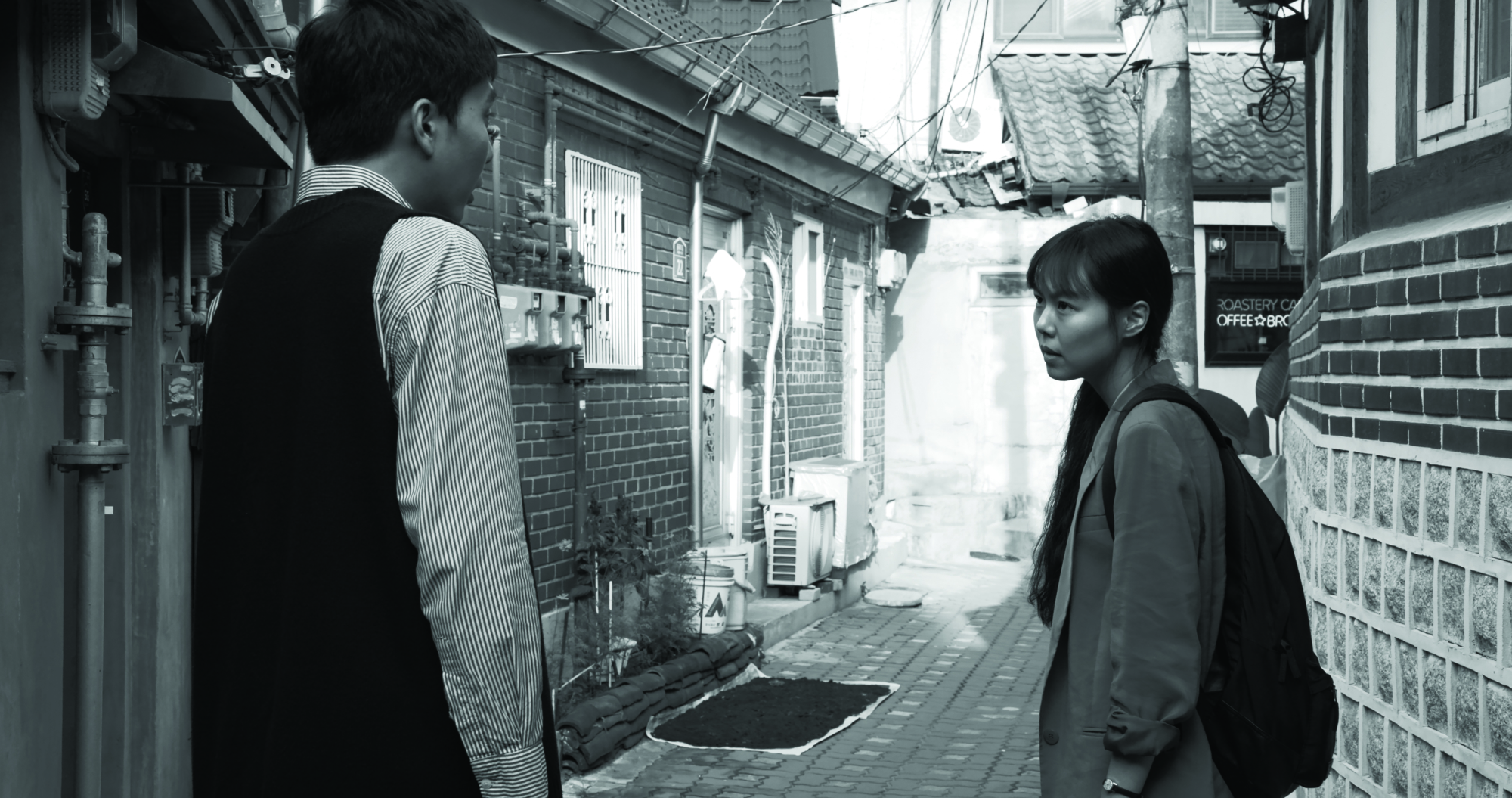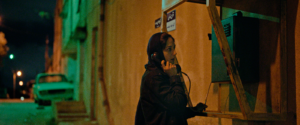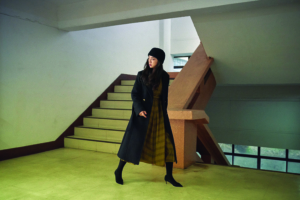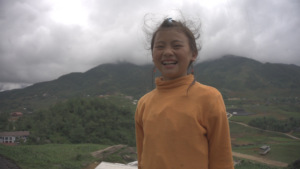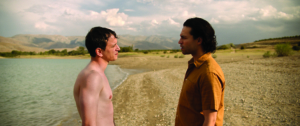In a second-floor room, a young woman picks up her phone from a table and swipes at the screen, as though willing an expected text or call to arrive. She diverts her attention to the window, where she stands on tiptoes, craning her neck. Anticipation denied again, she tramps downstairs to sit on a bench outside, the camera staying fixed at the head of the stairwell, looking down through the window at the bottom.
Frustrated once more – though it is not at all clear what or whom she is waiting for – the woman strides inside and up the stairs again, pausing at the top to gaze in futility at the unseen phone, still resting on the table. She marches back down, then up again. And then again and again over a two-minute period, the camera fixed in position. She walks up and down, the tension in her body slowly easing, a skip entering her step, until her frustration is replaced by a carefree, playful attitude.

This scene, occurring slightly over halfway through South Korean director Hong Sang-soo’s sixty-six-minute film Grass (2018), stands out as unusual, and not simply for the extended duration devoted to an apparently meaningless physical action. The woman herself, Ji-young (Kim Sae-byuk), appears in only two other scenes. Grass otherwise focuses on Areum (Kim Min-hee), a young woman who sits in the corner of a cafe and eavesdrops – and perhaps more – on the conversations of its other patrons.
The scene’s duration itself is not unusual; over the twenty-one other features Hong has made to date since his debut, The Day a Pig Fell into the Well (1996), he has become increasingly accustomed to attenuated shot length.[1]Marc Raymond, ‘Hong Sang-soo’, Senses of Cinema, issue 78, March 2016, <http://sensesofcinema.com/2016/great-directors/hong-sang-soo/>, accessed 22 May 2019. The quintessential Hong scene has a camera planted in place to capture a static shot of his characters working through some interpersonal drama (usually romantic, often involving infidelity) in combative dialogue – often while seated at a table in a cafe, bar or restaurant, and frequently while getting progressively more drunk. The length of each shot enhances the tension, usually comic, sometimes tragic, developed in the conversation (Hong’s an exquisite observer of the foibles of speech). Conversation, in fact, defines the majority of Grass, which unfolds as a series of encounters between six ‘couples’ – men and women – whom Areum alternately observes and engages with.
Hong’s films are dominated by conversation, but there’s physical movement, too, as characters go from bar to bar, or bar to bed, or take walks up mountains, or visit the beach, or take a trip overseas – though, existentially, they’re usually going nowhere. This aimlessness and frustration, frequently open-ended, in Hong’s work, is not often so explicitly compressed as it is in the scene involving Ji-yeong on the stairwell. As she locks into her stride, into her wordless passage up and down the steps, a tension seems to be dissipating; something is released. Moving in a loop, she is arriving at some place inside.
Hong’s films are dominated by conversation, but there’s physical movement, too, as characters go from bar to bar, or bar to bed, or take walks up mountains, or visit the beach, or take a trip overseas – though, existentially, they’re usually going nowhere.
Repetition has long appeared as the governing logic of Hong’s career. This manifests partly in a structural way: many of his films are organised as palimpsests, with scenarios and scenes that repeat themselves, the variations between them yielding narrative and emotional development. In 2015’s Right Now, Wrong Then, a date between a filmmaker and a painter is shown twice, with one version a disaster, and the other a success. In 2016’s Yourself and Yours, this repetition is enacted on the level of character, as a man’s wife walks out on him, only for her doppelganger to appear. Hong conducts these recurrences with a conceptual playfulness; his characters might be stuck in a time loop reminiscent of that in Groundhog Day (Harold Ramis, 1993), or in a dream, or simply in an existential rut.
But repetition also describes his filmography, as Hong has developed, over twenty-three years, an extraordinarily tight set of narrative and thematic concepts, frequently revolving around failed love affairs between lecherous, inconstant men (usually film directors or film professors, both occupations Hong has held) and thoughtful, slyly wise young women. His stylistic palette has become limited, too, and striking in its bald economy: his camera almost never mobile but fixed in place, his shots punctuated by blunt pans and zooms.
The persistent sameness makes Hong’s films hard to differentiate, a problem exacerbated by his extreme productivity, which sometimes now exceeds one film a year. Grass was his fourth to premiere in a single twelve-month period, and Hong has already released another since: 2018’s Hotel by the River. Avid Hong-watchers accept each new work as the latest entry in a single Hong ‘master text’ and look to the variations, hoping to sort his films into greater or lesser works by finding evidence of growth in their differences.[2]Marc Raymond, ‘Hong Sang-soo and the Film Essay’, New Review of Film and Television Studies, vol. 12, no. 1, 2014, pp. 22–36.
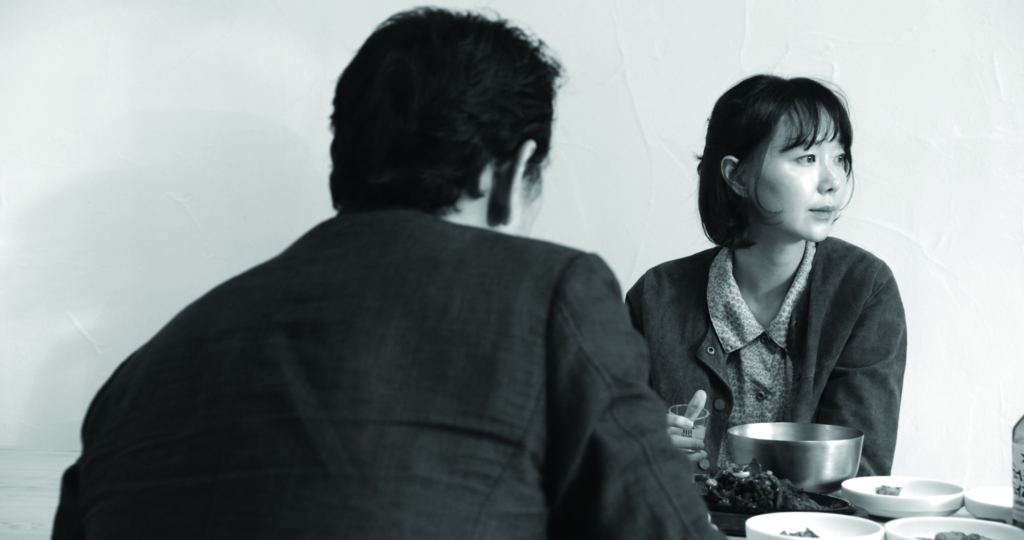
In Variety, critic Jessica Kiang characterises Grass as ‘deceptively potent’[3]Jessica Kiang, ‘Berlin Film Review: Grass’, Variety, 16 February 2018, <https://variety.com/2018/film/festivals/grass-review-berlinale-2018-1202686998/>, accessed 22 May 2019. – perhaps due to its modest running time in comparison to the director’s more ‘major’ recent works, like the 101-minute On the Beach at Night Alone (2017). This deceptiveness might also be chalked up to its typically casual and unadorned aesthetic. Shot in blunt digital with minimal locations, and presented in black-and-white, Grass lacks most of the aesthetic trappings that might otherwise mark a film as ‘quality’.
The potency of Grass arises from its compact, punchy restaging of its maker’s obsessions. The film begins with a typical Hong scene, as a young woman and man (Gong Min-jeung and Ahn Jae-hong) cautiously reacquaint themselves after some time apart. He is revealed to be a TV actor, while she claims to be jetting off to Europe. As these two haltingly converse, a backstory emerges: a mutual friend of theirs died by suicide as a result of a personal betrayal in which they are implicated. It’s only as this conversation winds up that Hong finally cuts to reveal his central character, Areum, seated in an opposite corner of the cafe – in voiceover, she begins to reflect on the young actor’s feelings of guilt.
Then, with a leftward pan from Areum, Hong brings into frame a second pair, an older man and woman (Ki Joo-bong and Seo Young-hwa), likewise reuniting after time apart. This older man is an actor, too, but no longer working, and makes reference to a recent suicide attempt. The woman keeps a mug of coffee on the table in front of her, while the man enjoys a soda – the same drink orders on the table of the first couple. Over scrupulously polite conversation, the man attempts to elicit from the woman an offer to house him in her spare bedroom, but she refuses. Areum, again in voiceover, puts a sour perspective on things, reflecting that the old man wants to mooch off his pretty, younger friend.
Hong’s chosen mode of conceptual playfulness involves Areum’s relationship to the scenes she alternately witnesses and participates in. Is she a neutral observer, or is she inventing parts – or even all – of the conversations around her?
By this point, the particular structure of repetition Hong has selected for Grass becomes apparent; each of the six pairings encountered across the film recapitulates part of the same primal drama, involving male weakness, infidelity and suicide. Hong’s chosen mode of conceptual playfulness involves Areum’s relationship to the scenes she alternately witnesses and participates in. Is she a neutral observer, or is she inventing parts – or even all – of the conversations around her? Are they manifestations of her own internal drama? Areum’s laptop, on which she is seen typing throughout, provides a clue. Some earlier Hong works, like In Another Country (2012), eventually reveal themselves as meta-narratives scripted by the young women within the films.
In the third encounter, a middle-aged man, Kyung-soo (Jung Jin-young) – also an actor – meets up with Ji-young, his younger female writer-friend, and makes a loaded proposal that they rent a holiday house in which to write together. Ji-young declines, and begs off to go and meet her boyfriend. In the fourth, Kyung-soo sits across from Areum, and makes another dodgy proposal: that he be allowed to ‘observe’ her as his writing subject; she proceeds to shoot down this proposition, claiming to also have a boyfriend, whom she then steps outside to ostensibly meet. But the young man awaiting her is her brother (Shin Seo-kho), and the fifth encounter is a three-way conversation in a restaurant between Areum, her brother and his fiancée (Ahn Sun-young). Whereas the reality of the prior four scenes felt only unconsciously shaped by Areum’s subjectivity, her bitterness now explicitly comes to the fore, as she ruthlessly questions the stability of her brother’s relationship.
A reverse cut towards the kitchen restaurant, and then a pan to another pair of patrons, introduces the sixth and final couple: a middle-aged professor (Kim Myoung-su) and a younger woman (Lee You-young) whom he cruelly excoriates for what he sees as her responsibility for the suicide of his colleague, with whom she was having an affair that was about to become public. The emotional intensity of this confrontation, during which the woman is reduced to tears, is enhanced by the unusual – for Hong – method of presentation. In contrast to a typical lateral two shot, Hong shoots from behind the man’s shoulder, and the woman’s face is racked in and out of focus throughout their conversation, as though the man’s accusations were somehow smudging her out of existence. At the peak of his denunciation, the camera pans leftwards, until only the man’s shadow on the wall is visible.
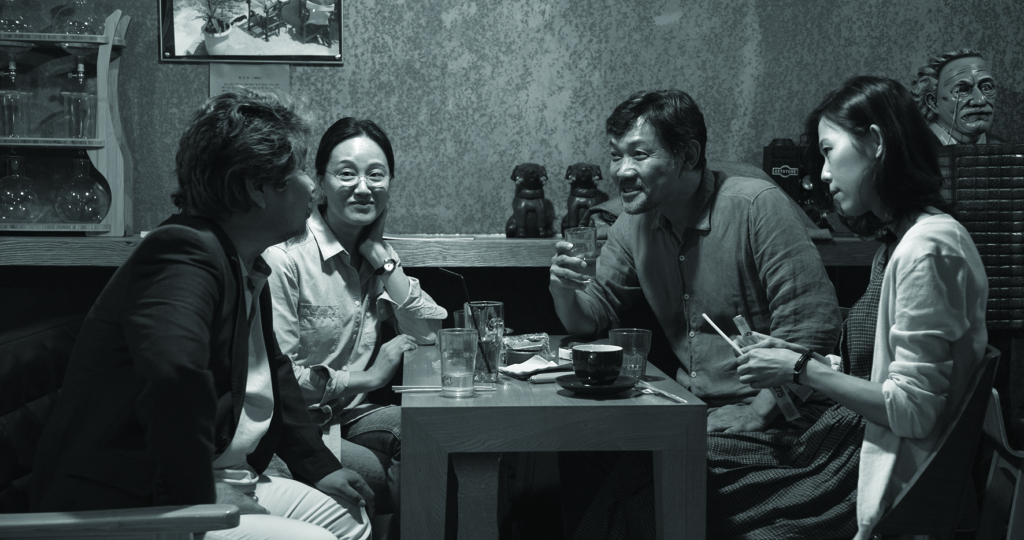
A reverse cut re-establishes Areum within the space of the restaurant, staring distractedly at her phone. Then the interlude with Ji-young on the staircase begins. Though the episode seems to occur outside even the uncertain reality of the rest of the film, being an event for which Areum herself is not present (and which she therefore cannot witness), the conceptual link between Areum looking at her phone and Ji-young looking at hers suggests that this Ji-young on the stairs is yet another fictive substitute. The meditative back-and-forth of her pacing acts as a tonal palate cleanser after the excoriating restaurant confrontation, and its therapeutic effect – the movement from frustration to play – introduces the emotional shift of the back half of the film; Areum’s anxiety, having reached a peak, begins to dissipate.
The remainder of Grass suggests a movement towards self-acceptance and peace. After a fight with her brother, Areum circles back to the cafe, where couples two and three (the older actor and older woman, and Kyung-soo and Ji-young) are now gathered together around a table, companionably drinking a bottle of soju they have smuggled in. The first couple, the young TV actor and woman, are reconciling, forgiving themselves for their part in their friend’s death; the woman reveals she never intended to go to Europe. Kyung-soo invites Areum to share their soju; she initially declines, but, after a short conversation with the young TV actor outside, she goes back in and joins their table. So the interlude on the stairs, though an unusual formal device for Hong, actually represents the pivot point for another of his bisected narratives, opening up space for a do-over: for Areum to not be a bitter fantasist projecting her private problems onto those around her, but to rejoin society, having released her troubles.
Hong-watchers have long been tempted to view his films as, if not autobiographical, then at least self-reflexively drawn from the stuff of his own life. This temptation was exacerbated in 2016, when it was reported that Hong had left his wife after admitting to carrying on an extramarital affair with Kim Min-hee, who has now appeared in six of his films, frequently as a character implicated in an affair.[4]See Ben Sachs, ‘Hong Sang-soo and Kim Min-hee’s Real-life Affair Yields a Trio of Films About Infidelity’, Chicago Reader, 12 July 2018, <https://www.chicagoreader.com/chicago/the-day-after-hong-sang-soo-kim-min-hee/Content?oid=52327354>, accessed 22 May 2019. There seems to be an element of automatic writing in Hong’s work, as though stories pour forth from his subconscious. He has said that he usually begins films with no more than a vague outline and a few locations, and shoots chronologically, getting up at four in the morning to write the script for the day and handing his actors their material only shortly before filming.[5]Lee Hyo-won, ‘Hong Sang-soo Explains His Improvisational Methods for Fast Filmmaking’, The Hollywood Reporter, 20 May 2017, <https://www.hollywoodreporter.com/news/hong-sang-soo-explains-his-improvisational-methods-fast-filmmaking-1005875>, accessed 22 May 2019. Editing is usually completed within days after filming has concluded, and a final assembly is locked in after a week or two of reflection.[6]Jordan Cronk, ‘Interview: Hong Sangsoo’, Film Comment, 1 July 2017, <https://www.filmcomment.com/blog/interview-hong-sangsoo/>, accessed 22 May 2019.
Grass foregrounds the possibly therapeutic function of Hong’s practice, revolving as it does around a character who creatively processes her problems by restaging them until she is able to move on. But it would be a mistake to view his films as simply elaborate private struggle sessions without also seeing that his uncommonly personal, fast and cheap production methods (his budgets average around US$100,000[7]Nicolas Rapold, ‘Films of Hong Sang-soo Capture Pleasures and Pratfalls of Attraction’, The New York Times, 17 May 2017, <https://www.nytimes.com/2017/05/17/arts/hong-sang-soo-films-at-cannes.html>, accessed 22 May 2019. ) have enabled the development of a highly sophisticated expressive language – one that, despite the barebones visual aesthetic, allows for a rich suite of formal and narrative possibilities as well as room for novelty, as Grass itself proves.

Is Hong, like Areum, moving on? It’s hard not to form questions relating to artistic progression or growth when encountering a major oeuvre expanding with such rapidity. Writing for Senses of Cinema, Marc Raymond argues that, from 2006’s Woman on the Beach onwards, Hong’s films begin to evince an increasing interest in female subjectivity, as his female characters start to wrest control of the narratives from the vainglorious men at their centre[8]Raymond, ‘Hong Sang-soo’, op. cit. – even to the point, as in Grass and In Another Country, where women become the fictive authors of the films themselves. The recent spate of work with Kim Min-hee can be read as a further development along these lines, as she has emerged as arguably the most formidable of Hong’s female leads. Whereas his previous female roles tended towards young, insecure characters, Kim’s Yoon Hee-jeong in Right Now, Wrong Then is fully self-possessed, and wryly funny in her ability to shield herself from the misbehaviour of the men around her – traits that have continued through her subsequent work with Hong.
But personal ‘growth’ – artistic or otherwise – is not a concept given much faith in Hong’s universe. What his characters really seek is absolution. In the back half of Grass, the four characters drinking soju remark on the kindness of the cafe owner, who is allowing his patrons to drink liquor smuggled in from outside. This discussion has an unmistakably religious undercurrent, which Hong underscores by never cutting to reveal the owner, an unseen authority who looks down benevolently on his subjects even as they indulge their bad impulses. If there’s a spiritual aspect to Hong’s work, it manifests as an edict for mindfulness, perceptible both in the individual texts and in his deeply focused body of work as a whole. Moving in circles permits one to not only gaze inwards but look upwards, to grace.
Endnotes
| 1 | Marc Raymond, ‘Hong Sang-soo’, Senses of Cinema, issue 78, March 2016, <http://sensesofcinema.com/2016/great-directors/hong-sang-soo/>, accessed 22 May 2019. |
|---|---|
| 2 | Marc Raymond, ‘Hong Sang-soo and the Film Essay’, New Review of Film and Television Studies, vol. 12, no. 1, 2014, pp. 22–36. |
| 3 | Jessica Kiang, ‘Berlin Film Review: Grass’, Variety, 16 February 2018, <https://variety.com/2018/film/festivals/grass-review-berlinale-2018-1202686998/>, accessed 22 May 2019. |
| 4 | See Ben Sachs, ‘Hong Sang-soo and Kim Min-hee’s Real-life Affair Yields a Trio of Films About Infidelity’, Chicago Reader, 12 July 2018, <https://www.chicagoreader.com/chicago/the-day-after-hong-sang-soo-kim-min-hee/Content?oid=52327354>, accessed 22 May 2019. |
| 5 | Lee Hyo-won, ‘Hong Sang-soo Explains His Improvisational Methods for Fast Filmmaking’, The Hollywood Reporter, 20 May 2017, <https://www.hollywoodreporter.com/news/hong-sang-soo-explains-his-improvisational-methods-fast-filmmaking-1005875>, accessed 22 May 2019. |
| 6 | Jordan Cronk, ‘Interview: Hong Sangsoo’, Film Comment, 1 July 2017, <https://www.filmcomment.com/blog/interview-hong-sangsoo/>, accessed 22 May 2019. |
| 7 | Nicolas Rapold, ‘Films of Hong Sang-soo Capture Pleasures and Pratfalls of Attraction’, The New York Times, 17 May 2017, <https://www.nytimes.com/2017/05/17/arts/hong-sang-soo-films-at-cannes.html>, accessed 22 May 2019. |
| 8 | Raymond, ‘Hong Sang-soo’, op. cit. |
